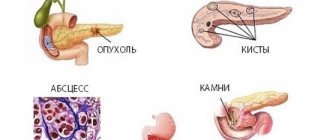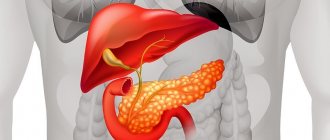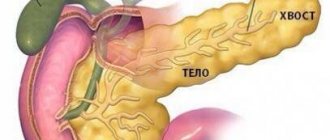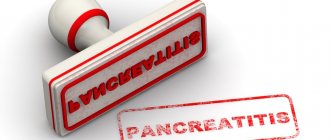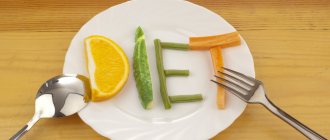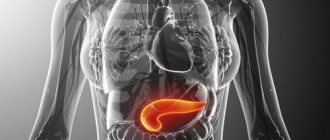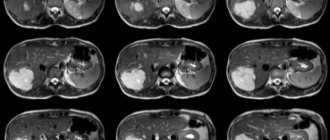Signs of pancreatic steatosis
When dead cells are eliminated from the tissues of the gland, they are replaced by fat cells, thanks to which the organ can maintain its size and shape, as well as its functioning.
Over time, such replacement processes provoke the development of a pathoprocess. In the gland, there is a decrease in the production of substances necessary for the full functioning of the body, which leads to various disorders.
An inflamed pancreas like steatosis “makes itself felt” already in the later stages of pathology development, when most of the glandular cells are replaced by fatty cells. This is accompanied by the following manifestations:
- Malfunctions of the gastrointestinal tract. The patient experiences frequent nausea, indigestion, heartburn, loss of appetite, and food allergic manifestations.
- Soreness in the upper abdomen and under the ribcage.
- Severe weakness.
- Dry and yellow skin, most often around the eyes and in the eyeballs themselves.
In the case when, with the development of obesity in the pancreas, the liver is also affected, in which the same degenerative changes occur, new symptoms are added:
- swelling in the lower extremities;
- icteric spots on the surface of the skin;
- pain in the right hypochondrium;
- liver enlargement;
- bitter taste in the mouth.
You can learn about other symptoms accompanying pathologies in the gland from the article.
Causes
In very rare cases, the disease is transmitted at the genetic level. Usually the person himself is to blame for its development. His desire for pleasure with the obligatory refusal of a healthy lifestyle makes him calmly treat signals about deviations in the functioning of the body’s systems.
The main factors provoking diffuse pancreatic steatosis can be divided into three main groups.
Toxic effects:
- Alcohol consumption. To develop the disease, it is not necessary to regularly and in large quantities abuse alcoholic beverages. Some patients indulge in drinking alcohol for a long time before the pathological process begins. For others, just a few sips are enough.
Important! Those who drink alcohol with fatty foods are especially at risk. For example, lard and vodka, beer and smoked wings.
- Smoking.
- Taking medications. Treatment of other pathologies often requires the use of glucocorticosteroids or antibiotics. Both groups of drugs can cause pancreatic cell death.
Metabolic factors:
- Inflammatory processes of the pancreas. The result of inflammation is the active destruction of cells. The resulting voids are quickly filled with adipose tissue.
- Excess body weight.
- Violation of nutritional standards. Preferring healthy food to poorly digestible food, which is convenient to buy on the way to work or home, leads to serious stress on the entire digestive system and can cause the gradual death of the gland.
- Diabetes.
Surgical intervention:
- Many advanced diseases of the digestive system or those occurring with complications require immediate surgical intervention. However, any operation in this area can cause serious damage to the pancreas.
Read about how the pancreas hurts and what happens during an attack of pain here.
Steatosis of the pancreatic parenchyma: diagnosis
To make a diagnosis, taking into account the symptoms listed above, a specialist may prescribe certain diagnostic tests that will determine the degree of fatty infiltration in the gland. This will make it possible to refute or confirm the preliminary diagnosis.
If lipomatosis is suspected, it is most often necessary to perform:
- Blood analysis . It can be used to determine the level of alpha-amylase. At increased concentrations, we can talk about the presence of fatty changes in the organ.
- Ultrasound. Recommended for identifying the degree of echogenicity and size of the pancreas and liver.
- MRI. Allows you to thoroughly examine the organ, identify possible areas of damage and exclude the presence of tumor changes.
- X-ray. A contrast agent is added for the study, which makes it possible to study all the ducts of the gland.
What other tests are performed to diagnose the condition of the pancreas, read the article.
If the research methods performed are not enough, the specialist may prescribe additional laparoscopy or biopsy. With these invasive techniques, more accurate data can be obtained.
Prerequisites for the development of steatosis and its stages
The disease develops asymptomatically, so the person does not see or feel any changes, which provokes further damage to the organ. Taking into account the changes and the degree of their severity, as well as the percentage of replacement of normal cells with fat cells, several degrees of fatty degeneration in the pancreas are distinguished:
- First. There is a 30% replacement of healthy organ cells. There are no symptomatic manifestations.
- Second. Replacement 30-60%. Minor primary symptoms (most often gastrointestinal disorders).
- Third. More than 60% changes in tissues. There are disturbances in the functioning of the immune system and other pathologies.
With fatty degeneration in the tissues of the pancreas, the body experiences an acute lack of enzymes and endocrine substances produced by the organ. This, in turn, provokes disturbances in other systems, for example, a reduction in insulin levels occurs, i.e. glucose metabolism decreases.
The prerequisites for these pathological disorders in the tissues of the gland are:
- operations that were performed in the gastrointestinal tract;
- long-term smoking and drinking alcohol-containing drinks;
- non-compliance with the diet (consumption of fatty, smoked foods);
- gallstones;
- inflammation, fibrosis, cyst in the pancreas;
- cholecystitis (chronic);
- obesity;
- diabetes mellitus (or type 2).
Rarely, steatosis can be caused by a hereditary predisposition.
The risk group includes: women over 60; men – over 50 years old.
Against the background of steatosis, cirrhosis of the liver can form, which is accompanied by a high risk to human health and even life.
Description of the disease
With this pathology, lipids accumulate inside cells, as a result of which they lose their properties, or in the intercellular space. Most often the problem occurs in the liver, a little less often in the pancreas.
Since the reasons for the deviation are the same, fatty infiltration can often appear in both organs simultaneously or follow each other.
People with this diagnosis often ask the question of what it is – fatty hepatosis of the pancreas – and how to treat it. The disease almost always occurs as a secondary process against the background of other pathological phenomena or metabolic disorders.
Since the disease progresses slowly and irreversibly, many patients begin to be examined and treated very late. The doctor can only prescribe medications to prevent further progression of the pathology.
Important! An annual ultrasound can detect the disease at an early stage. In this case, it is possible to prevent its progression. This is especially true for people at risk.
How to treat pancreatic steatosis?
Depending on which area of the organ is affected, the specialist selects the most optimal method of therapy, and the presence of concomitant pathologies is also taken into account.
If there is a small amount of fat in the gland, it will not interfere with standard work, so a therapeutic method of treatment is prescribed, which includes:
- Taking medications aimed at restoring the standard amount of enzymes.
- Medicines designed to reduce the production of hydrochloric acid in the stomach.
- Agents that accelerate the removal of fats from the gastrointestinal tract.
- Strict diet with reduced fat intake.
- Normalization of body weight (for obesity).
In case of extensive obesity of the pancreas, when compression of the ducts is noted, surgery is necessary. During this procedure, the most dangerous areas of lipomatous tissue are excised.
As a result of the therapy, the person’s condition is normalized, the functioning of the gland is stabilized. However, the pathology cannot be completely cured, because changes that have occurred in tissues are irreversible.
Diet
Diet for pancreatic steatosis is the main component of treatment. The diet should be low in calories, contain the physiological norm of protein with a sharp limitation of fats and carbohydrates. It is also necessary to take into account the fact that meals should be fractional - you need to eat 5-6 times a day, but in small portions. When following a diet, the patient should eat boiled or steamed food. The consumption of fried, fatty, salty, smoked and spicy foods is strictly prohibited. Sour and canned foods are also prohibited. It is necessary to stop drinking alcohol and smoking. It is necessary to remove sweets and baked goods from the diet. It is not recommended to consume dairy products with high fat content.
You need to forget about coffee and carbonated drinks. You can drink weakly brewed black or green tea. The daily menu should contain products that accelerate the breakdown and removal of fats. These include low-fat fish, boiled beef and poultry, soy, buttermilk, low-fat cottage cheese or with a small percentage of fat content (no more than 5%).
Preference should be given to light soups with cereals and vegetables. To prepare porridges, it is better to use rice, rolled oats and buckwheat. Vegetables you can eat: potatoes, zucchini, eggplant, pumpkin, radish, cucumbers, cauliflower, tomatoes.
A specially designed nutritional system must be followed at all times. Strict adherence to a therapeutic diet will help prevent complications and progression of the disease.
Treatment of steatosis with folk remedies
The pancreas can be treated with unconventional methods. The use of traditional medicine recipes is an effective addition to prescribed therapy and diet. Herbal remedies not only help eliminate symptoms, but also help stop the growth of fat cells.
Pancreatic steatosis in the initial stages can be treated at home with the help of herbs. As a remedy, you can use an infusion prepared from immortelle and chamomile flowers. It will require 2 tbsp. l. pour a glass of boiling water over dry crushed raw materials. Infuse the liquid for 30 minutes. Take the prepared infusion 100 ml 3 times a day 20 minutes before meals.
A popular and useful remedy in the fight against steatosis is a decoction of blueberry leaves. To prepare it you need to take 1 tbsp. l. fresh crushed leaves or 1.5 tbsp. l. dry, pour 250 ml of boiling water and boil over low heat for 10 minutes. After the broth has cooled, strain. Take 2 times a day, 100 ml.
For diseases of the pancreas, oat decoction is widely used. It must be prepared as follows: pour 1 glass of unrefined grain into 1 liter of water and leave for 8–9 hours. Then put on fire, bring to a boil and simmer for about 30 minutes. Wrap the container with the broth in a towel and let it brew for 12 hours. Then strain the broth and add boiled water to the original volume. Drink the resulting drug in the morning on an empty stomach, 150 ml.
It is important to remember that preventing steatosis is easier than treating it. Therefore, it is better to follow a diet and lead a healthy lifestyle.
